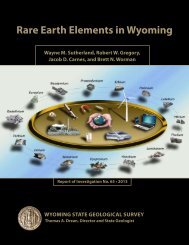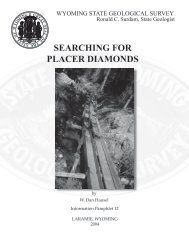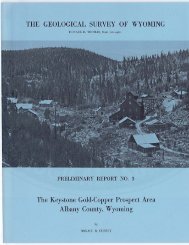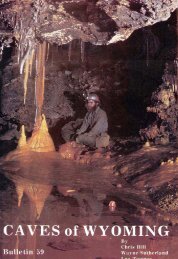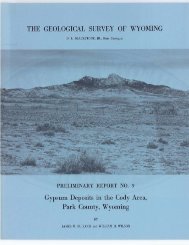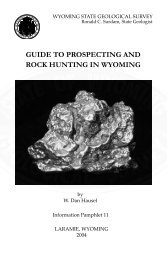The Dinosaurs of Wyoming - Wyoming State Geological Survey ...
The Dinosaurs of Wyoming - Wyoming State Geological Survey ...
The Dinosaurs of Wyoming - Wyoming State Geological Survey ...
Create successful ePaper yourself
Turn your PDF publications into a flip-book with our unique Google optimized e-Paper software.
54 THE DINOSAURS OF 'WYOMING<br />
Microscopical study (Figures 15, 17) shows the presence<br />
<strong>of</strong> scattered lacunae, once occupied by the bone cells; spindleshaped<br />
bodies with short canaliculi. A section <strong>of</strong> bone taken<br />
from the very middle <strong>of</strong> the tumor shows more compact bony<br />
structure than exists at the periphery (Figure 17).<br />
Other accidents to the enormously elongated tail <strong>of</strong> the<br />
amphibious (sauropod) dinosaurs are known, and have been<br />
described by Hatcher, Holland and Osborn (Figures 9, 10,<br />
12 c, 13 a, b, d). <strong>The</strong>se injuries indicate that the tail was<br />
either dragged over rough ground, was used as a flail, or was<br />
used in swimming, or perhaps all three. One type <strong>of</strong> pathological<br />
change <strong>of</strong>ten seen in the tail <strong>of</strong> the sauropod dinosaurs<br />
was a thickening, or ossification <strong>of</strong> the longitudinal ligaments,<br />
producing a condition called Spondylitis deformans, which is a<br />
very ancient diseased condition, known from early Mesozoic<br />
times, and extremely common at the present time.<br />
An infected injury is seen in the tail <strong>of</strong> a large dinosaur<br />
mounted in the Carnegie Museum at Pittsburgh.<br />
Lesions similar to those associated with rheumatism are<br />
known in the dinosaurs, and some <strong>of</strong> them had tooth troubles.<br />
A large dinosaur skeleton, mounted in the United <strong>State</strong>s<br />
Tational Museum (Figures 24, 40, a), shows in one hip a huge<br />
bone abscess, due doubtless to a bone injury.<br />
A large hook-like exostosis, following an infection, is seen<br />
on the inner face <strong>of</strong> a shoulder-blade <strong>of</strong> a three-horned dinosaur<br />
(Figure 40). <strong>The</strong> pathological growth was partly covered<br />
by muscle, but it may have rubbed against the ribs.<br />
Pathological outgrowths exactly like this are <strong>of</strong>ten seen on<br />
modern human bones.<br />
All together there is a known array <strong>of</strong> fifteen different<br />
types <strong>of</strong> pathological processes found among Mesozoic reptiles.<br />
Some <strong>of</strong> these conditions are called arthritides, multiple<br />
arthritis, arthritis deformans, tumors <strong>of</strong> two types, necrosis,<br />
hyperostoses and various kinds <strong>of</strong> fractures and slight injuries.





